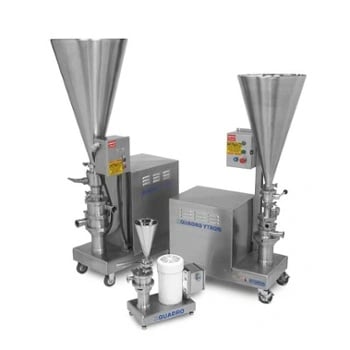Powder dispersion is the method of combining solids, primarily powders, into water or other liquids. Whilst in-tank mixing is sufficient for a few types of powders, some powders are more difficult to disperse and require high shear powder dispersion equipment to create high quality dispersion.
A common challenge for process engineers is rafting, agglomeration or fisheyes when working with difficult-to-disperse powders. These are typically thickening agents used in the cosmetic, food and pharmaceutical industries, such as high-molecular-weight hydrocolloids, xanthan gum, cellulose gums, starches or proteins.
More specifically, issues with powder dispersion include:
- Powder floating where some powers float on the liquid surface making them difficult to mix and therefore increases batch time.
- Fish eyes where powders clump into impenetrable sticky masses, thereby affecting the quality of the batch.
Powder Dispersion Techniques
There are a range of industrial dispersers that are used as powder dispersion solutions, each with their own unique features.
In-tank mixing struggles to achieve consistent particle size distribution and deagglomeration with challenging powders and can result in air entrapment in the mix due to vortexing in the tank.
These problems are solved by using a traditional inline high shear rotor-stator dispersing mixer. They reduce overall footprint in a production facility, allow for continuous inline mixing and can significantly reduce batch time.
What is Inline Mixing?
An inline mixer is composed of a static stator and an internal rotor that spins at a high speed. This device is kept in a housing with an inlet and outlet, and the rotor is driven through a seal. The sample flows through one of the mixing heads into the shearing zone while the teeth rotate and is then expelled at a high velocity through an opening in the rotor/stator.
Inline mixers are useful for production of large amounts of material and the homogenization of products during the manufacturing process. They are equipped to manage a variety of tasks including emulsifying, blending, suspending, smoothing and dispersing.
Inline Powder Mixing Equipment - The Quadro Ytron® ZC Disperser
The Quadro Ytron® ZC is a high shear dispersion mixer designed to incorporate and disperse particularly difficult-to-disperse powders into a liquid stream in a single pass which, for many manufacturers, eliminates the need for additional equipment, dispersants or wetting agents and significantly reduces batch time.

This high shear inline mixer is able to achieve a solids dispersion of up to 70% by weight. It utilizes the Quadro® Uniform Film Interface (UFI) powder disperser technology to maintain a high degree of control accuracy in continuous mixing applications, with achievable inline concentrations of 50% by weight or higher.
Manufacturers are able to save much as 75% in batch times as a result of the high shear technology. Even with difficult products such as hydrocolloid gums, cellulose gums and carbomers, you achieve complete dispersion in a single pass.
What is an Inline Mixer Used For?
The ZC can be used as a powder mixer for cosmetics and personal care, food, pharmaceutical and chemical products – a few examples are below:
| Industry | Products |
| Personal care and cosmetics |
|
| Food |
|
| Pharmaceutical |
|
| Chemical |
|
Benefits of Inline Powder Mixing
Below are some of the benefits of the Quadro Ytron® ZC disperser:
- Improved product quality - Results are completely free of lumps and ‘fish eyes’
- Consistent and repeatable results batch to batch
- Reduced or no product waste
- Batch time reductions of up to 90% due to high-speed dispersion which reduces cleaning times and no waiting for the wetting of floating powders
- Scalable dispersion equipment from pilot to production
- Meets 3-A® sanitary standards and lowers risk of cross-contamination
- Minimal air entrapment eliminates the time and expense required to de-aerate
- Overprocessing to eliminate lumps is eliminated, which is vital for heat or shear-sensitive products
Related reading
Topics:
Powder Dispersion

